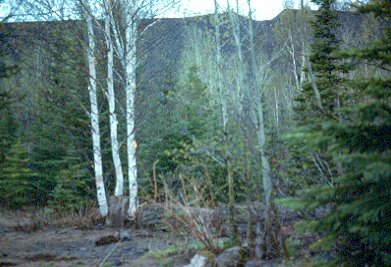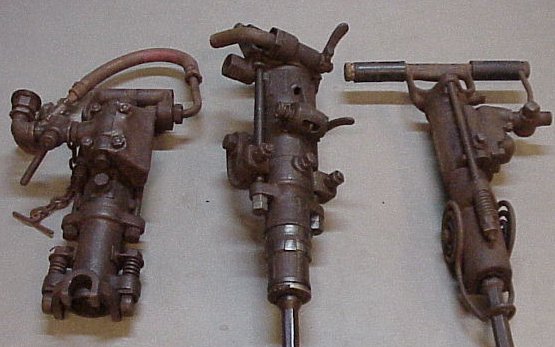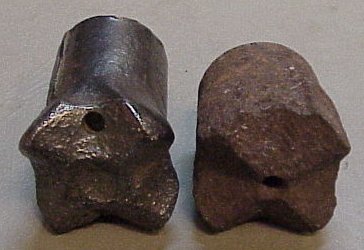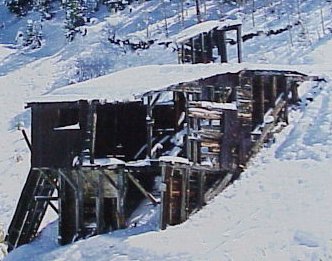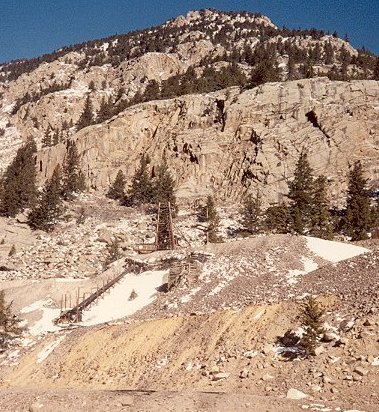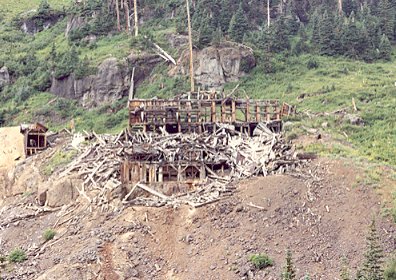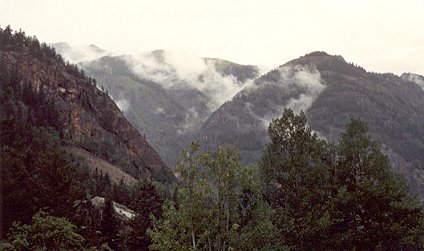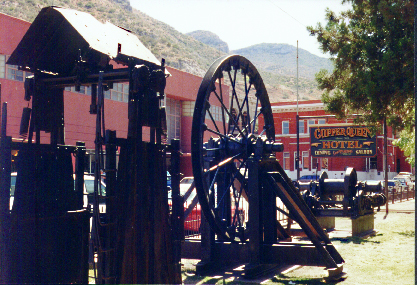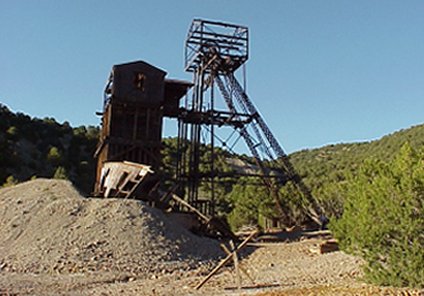Old Mine Exploration
One of the most fun and exciting aspects of mining artifact collecting is exploring old mine sites. Depending upon one's physical condition, willingness to take calculated risks, innate curiosity, willingness to get extremely dirty and willingness to put your well-being in someone else's hands, you can elect to explore old mine sites above and/or below ground. In order to explore old mine sites above ground you merely need to find where they are located. This can be done with old maps that pinpoint the location of old mines. If so inclined, you can visit an old mining district and merely start hiking through the woods, climbing hills and mountains or trekking through the desert Southwest seeking remnants of old mines. This particular means of locating old mines is not recommended as in many areas old mine shafts have not been safely sealed or secured. Some have been covered over with loose debris over the years and are not easily seen, others have caved in and merely look like depressions in the ground
Old Michigan copper mine shaft that would be difficult to locate if you did not know what you were looking for.
V
I
I
Some old mine shafts have been "secured" by barbed wire on wooden posts. Many times these posts have rotted away and the wire has rusted away. Sometimes the site has been re-secured but many times the sites are forgotten. Other times old shafts have been covered over by boards which have become rotten over the years. Considering that many of these mines closed prior to 1900 it is reasonable to assume that many mines never had their shafts secured in any long-term manner when the mines were abandoned.
An old caved-in Michigan copper mine shaft that has been secured with new steel posts and barbed wire.
An old open Michigan copper mine shaft that has not been secured in any manner and that poses a threat to the unwary.
A well secured mine shaft at the Minesota Mine, Ontonagon County, Michigan. Sections of steel rails have been fastened in place and covered with steel grating, it isn't pretty but it is effective.
There is no problem with locating the site of old mines when either remnants of structures remain or when entire mine structures remain. Other indicators of old mine sites are poor rock or tailing piles, also know as mine dumps, some of which can be quite extensive. Some times they are barren of vegetation and in other cases are so old that they are completely overgrown and difficult to locate.
Structural remnants in the foreground and a complete surviving shaft house in the background at the Champion Mine, Painesdale, Michigan-
Surviving structures at the Ahmeek Mine, Ahmeek, Michigan. Remains of poor rock piles to the left.
Remaining house at site of the Phoenix Mine, Phoenix, Michigan.
Arrow indicates the location of the poor rock pile from the West Vein Mine which is largely overgrown.
V
I
I
Site of the Phoenix Mine stampmill with large poor rock piles in the background
Something that can be collected from the mine dumps are specimens of the mineral product that the mine produced as well as associated minerals. In the case of the Michigan copper mines you can find native copper and silver, as well as datolite, epidote, calcite, analcite, chlorastrolite, and many other minerals. Copper specimens are found much more readily and in greater quantity with the use of a metal detector. Copper can be found in sizes from the head of a pin to many pounds, but small pieces with more rock than copper is the rule. The largest specimen of solid copper, with no rock, that we have found is a piece of glacial float copper found with a metal detector that weighs 300+ lbs. Float copper pieces weighing multiple tons have been uncovered over the years.
Searching the mine dump of the Arnold Mine with a metal detector
Sometimes you get lucky and find a good-sized chunk of copper that the miners missed. This piece weighed more than 100 lbs. when found on the Phoenix Mine dump.
When finally cleaned the chunk of native copper found on the Phoenix Mine dump weighed in at 98 lbs.
Finding this chunk of copper was one thing, it was another to haul it more than 100 feet
up the side of the mine dump to where we parked our vehicle. These mine dumps are very steep with loose rock that slides with every step.
Underground Exploration
Underground mine exploration is an activity that should not be undertaken lightly, recognize from the start that there is risk attached and take all reasonable precautions before starting. Here are a few simple precautions that are worth remembering:
1) Never go underground alone.
2) Always let someone who is staying above ground know where you are going and when you plan to return.
3) When you are a beginner go with someone who knows what they are doing to gain some experience before striking out on your own.
4) Use proper equipment and know how to use it - lug sole boots, a hardhat with cap lamp, a backup lighting source for each person (I prefer two backup light sources), leather work gloves, and for vertical entry proper descending/ascending gear. I take a canvas shoulder bag, a small pry bar, rock hammer, and a folding shovel/pick. I also
carry an air monitor that gives constant readings of the oxygen content of the air.
5) Remember that nothing you will see or find underground is worth losing your, or someone else's, life for.
6) Once underground always watch where you step.
7) Always watch for loose rock and timbers.
There are essentially three ways that you can enter old mine workings: 1) walk in through a horizontal adit, 2) descend down a sloped or inclined shaft or 3) drop down a vertical shaft with ropes. Walking in a horizontal adit is by far the easiest but the least likely to produce any mining artifacts as someone has most likely been there before you unless you are lucky enough to find a mine in a very remote.or inaccessible area. The difficulty of a sloped shaft is generally determined by the degree of slope, the steeper the slope the more difficult and risky the descent and ascent. The vertical shaft is the most risky mine entry. You should be aware of the dangers of a bad collar on the shaft, some shafts just shouldn't be entered, if in doubt don't do it. Any time you are in the shaft while descending or ascending you are potentially in the path of any falling object from above.
Entering an easily accessible horizontal adit,
easy to access, after a long hike that is.
A sloped shaft or inclined shaft at a Michigan copper mine ready for entry.
A vertical manway shaft in a Michigan iron mine. We were able to gain entry and climb the ladder in and out after getting permission from the owner of the company doing demolition of the above ground mine workings, the fact that I have known him for years helped. Everything is covered with red iron dust.
Ron cleaning rock from a native copper and silver specimen, sitting with his back to a vertical shaft, after we had come up.
This open shaft is not something you'd want to fall into.
Part way down a dark shaft.
Once you reach a level you can take off exploring. Notice the lack of mine rail in this drift.
Here the rail has been removed but the remains of the cross-ties are evident.
Here the drift opens up into a large stope to the right, we searched the loose rock for native copper and silver
A 12" chunk of native copper sticking out the rock wall, unfortunately there was no way to remove it.
Hey, there's light up ahead, we're almost out.
What you are able to find underground is going to depend upon many factors, such as the accessibility of the mine, has it been searched previously, is it a damp Lake Superior mine or a dry desert Southwestern mine, and what was removed when the mine closed. Mines that are not readily accessible and in a remote location are least likely to have been visited by many others. Many mining regions have very damp underground environments that plays havoc with iron and steel, wood, cloth, leather and paper items. On the other hand, the desert Southwest has many mines with a very dry environment in which 100 year old newspapers can be found that are still able to be read, iron and steel is not heavily rusted, wood, leather and cloth items are well preserved. Some mines were stripped of virtually all their equipment and tools when they were abandoned, others were left looking like the miners expected to come back for the next shift. Some of the items sought by collectors are powder and candle boxes, cap tins and fuse wrappers that were left behind as garbage.
Artifacts found underground in a Michigan copper mine: 1) 8 lb. hammer head, 2) chisel used for cutting up large pieces of copper so they could be removed from the mine, 3) hammer/pick head, 4) two pieces of a broken copper chisel like number 2, 5) chisel head, 6) copper chiselings made in the process of cutting up large pieces of copper underground, 7) hand forged iron hanger pulled from a mine timber, 8) the sole of a hob-nail boot, 9) found above ground.
1
2
3
4
5
6
7.
8
9.
Closeup of the sole of a hob-nail boot, the leather upper had long ago rotted away.
While many artifacts are dirty and rusty when you find them they do not necessarily have to remain that way. The drill bit on the left has been cleaned and the one on the riight is as found.
A group of tools found underground in Michigan copper mines that have been prepared for display.
Three different pneumatic rock drills found below ground level in collapsed buildings at Michigan copper mines,
Small riveted iron sinking bucket found in a Michigan copper mine. This is in the best shape of the three I have found, the other two are much more heavily rusted
Perhaps this short presentation has enticed you to try exploring old mines and mine sites, perhaps it has not. If you decide to go exploring just remember to do it as safely as possible just as you would when scuba-dving, hang-gliding, sky-diving, snow or water skiing, kayaking, mountain biking and other activities. Happy hunting!
Exploring Mines Outside of Michigan's Copper Country
While Michigan's Copper Country is my favorite Mining District, I like to explore old mining sites
anywhere I travel. Below are an assortment of photos from some of the old mining sites I have visited, some are scanned 35mm slides so they are not too sharp.
While Skiing in Colorado it is not unusual to come across the remnants of mining operations, here I am looking out over such an area.
Old mine buildings next to a Colorado ski area.
More mining ruins adjacent to a Colorado ski area.
Alley Belle Mine near Romley, Colorado.
Mine ruins at Animas Forks, Colorado
Jana standing in front of ruined log cabins at Alice, Colorado
Mine remnants at Alice, Colorado.
Ore bins at mine site near Alice, Colorado.
Terminus of the tram for the Little Nation Mine at Howardsville, Colorado.
National Belle Mine headframe at Red Mountain, Colorado.
Mine ruins above Central City, Colorado
Tunnel on Phantom Canyon Highway (some highway, it's a dirt road), the scenic route into Cripple Creek, Colorado.
Mine at Victor Colorado.
Mines on Battle Mountain at Victor, Colorado..
Independence Mine (left) on Battle Mountain Victor, Colorado.
Me with the descendants of prospectors' burros that wander the town of Victor, Colorado today.
An unidentified mountainside mine in Colorado.
Stanley Mine near Idaho Springs, Colorado.
Mine dump near Georgetown, Colorado.
Unidentified mine site near Silver Plume, Colorado
Five head stamp at a mine site in Colorado.
Yankee Boy Basin Road near Ouray, Colorado.
Atlas Stamp Mill near Ouray, Colorado.
Ruins of the Atlas Stamp Mill.
Looking out of a mine above Ouray, Colorado.
Ore chute underground in an abandoned Colorado mine.
Governor's Pass above Ouray, Colorado.
Smuggler-Union tram house near the Tomboy Mine, used to lower ore to the Smuggler-Union Mill below.
Remains of a 10 stamp mill in Maggie Gulch, Colorado.
Mountain Top Mine Governor Basin, Colorado.
Unidentifed mine remains near Boulder, Colorado.
Monte Christo Mine at Constellation Camp, Arizona.
Looking down the shaft of the Monte Christo Mine.
Open mine shaft in the Black Mountains of Arizona.
Morenci Mine at Clifton, Arizona.
Unidentified mine ruins at Gleeson, Arizona.
Old mining equipment displayed in Bisbee, Arizona.
Two seat "potty" car Bisbee, Arizona.
Kelly Mine, New Mexico.
Gilbert Mine, Nevada.
Shaft at the Gilbert Mine in Nevada.
Not the way to go underground, where's the hardhat and two sources of light?
Heading out with our arms full after finding some copper and silver specimens, as well as a few rusty iron artifacts.







